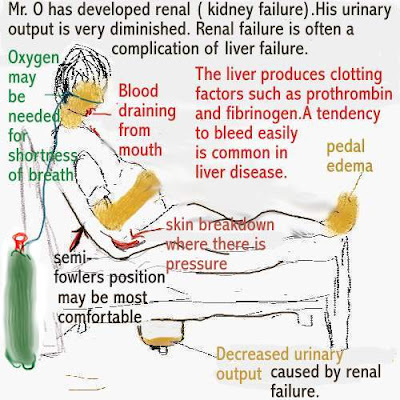
Failure of the
kidneys to do their normal function is very distressing to the patient. Patients may become
confused because of the retained waste products. Pruritis ( itching) is also common.
Urinary output in renal may be absent ( anuria) or low(oliguria).
CAUSES OF
RENAL FAILURE :
Hypovolemia - excessive volume depletion from vomiting ,
diarrhea ,
blood loss or diuretics result in decreased blood flow to the kidneys and are reversible by correction of the problem.
Drug induced renal failure may or may not be reversible.
Antibiotics, contrast material used in
radiographic studies, anti- inflammatory drugs may all be causes of renal failure. Monitoring of
lab values for certain drugs like Gentamicin will be an indicator of when levels are becoming toxic. Dopamine infusion which is used to increase blood pressure, may result in decreased urinary output when used in high doses.Certain vitamin supplements may cause kidney stones.
Trauma whether blunt or penetrating ,
surgical procedures may damage the kidneys.
Enjoy reading and learning more about
Renal Failure and Transplantation,(chapter 10). at

.jpg)










.JPG)


.JPG)
